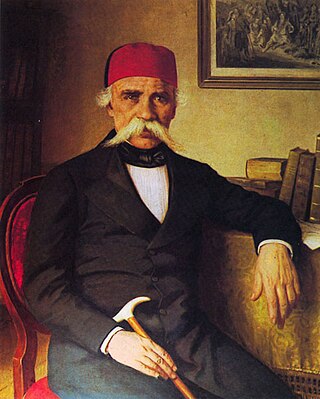
Vuk Stefanović Karadžić was a Serbian philologist, anthropologist and linguist. He was one of the most important reformers of the modern Serbian language. For his collection and preservation of Serbian folktales, Encyclopædia Britannica labelled him "the father of Serbian folk-literature scholarship." He was also the author of the first Serbian dictionary in the new reformed language. In addition, he translated the New Testament into the reformed form of the Serbian spelling and language.

Krupanj is a town and municipality located in the Mačva District of western Serbia. The municipality has a total population of 17,295 inhabitants, while the town has a population of 4,429 inhabitants.

The Mačva District is one of eight administrative districts of Šumadija and Western Serbia. It expands in the western parts of Serbia, in the geographical regions of Mačva, Podrinje, Posavina, and Pocerina. According to the 2011 census results, it has a population of 298,931 inhabitants. The administrative center of the Mačva district is the city of Šabac.
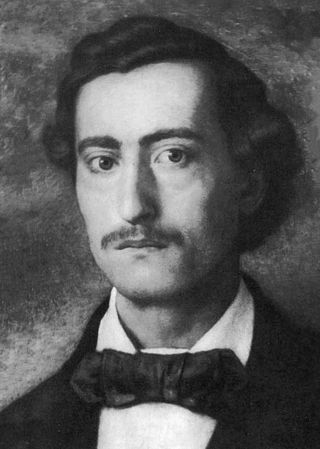
Aleksije "Branko" Radičević was a Serbian poet who wrote in the period of Romanticism.

Banja Koviljača is a popular tourist spot and spa town located in the city of Loznica, Serbia. Situated on the west border of Serbia by the Drina River and 137 kilometres (85 mi) from Belgrade, it is the oldest spa town in Serbia. As of 2011 census, it has 5,151 inhabitants.

Loznica is a city located in the Mačva District of western Serbia. It lies on the right bank of the Drina river. In 2011 the city had a total population of 19,572, while the administrative area had a population of 79,327.

The Serbian Cyrillic alphabet is a variation of the Cyrillic script used to write the Serbian language, updated in 1818 by Serbian linguist Vuk Karadžić. It is one of the two alphabets used to write standard modern Serbian, the other being Gaj's Latin alphabet.

Vukov Spomenik or colloquially Vuk is an urban neighborhood of Belgrade, the capital of Serbia. It is located on the tripoint of Belgrade's municipalities of Zvezdara, Palilula and Vračar, and served by the underground Vukov Spomenik railway station.
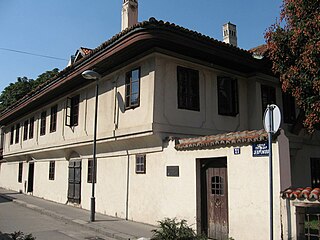
The Museum of Vuk and Dositej is one of the most important memorial museums in Belgrade, the capital of Serbia. Founded in 1949, it depicts the life, work and legacy of Vuk Stefanović Karadžić (1787–1864), the reformer of the Serbian language, and Dositej Obradović (1742–1811), a writer who was the country's first Minister of Education. The museum is a crucial site for understanding the revival of Serbian culture at the time of the First Serbian Uprising against the Ottoman Empire. Since 1979, this institution has been governed by the National Museum of Serbia.
Old Rashko or Old man Raško was a Serbian storyteller and gusle player (guslar) known as one of the most important sources of the epic poetry recorded by Vuk Karadžić.

The Tronoša Monastery is a Serbian Orthodox monastery between the villages of Tršić and Korenita, in the administrative town of Loznica, in western Serbia. It is ecclesiastically part of the Eparchy of Šabac. According to tradition, the monastery was built by King Stefan Dragutin.
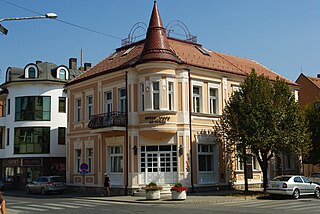
The Jadar Museum is a history museum located in Loznica, Serbia. It has a permanent collection dedicated to man's activities in the area of Podrinje from prehistory until 1950. The museum is housed in the Old Pharmacy Building, which is the cultural monument of great importance.

Tanja Kragujević a Serbian poet, was born in 1946 in Senta, northern Vojvodina. She has been a member of the Serbian Literary Society since its foundation in 2001. By the decision of the Government of Serbia, 24 December 2009, she was awarded the title of top artists in the field of literature. She lives in Zemun.

A srbulјa, srbulje in plural, is a liturgical book written or printed in the Serbian recension of Old Serbian (Serbo-Balkanic), which was the written language of Serbs from the 12th century to the 1830s. The term was used for the first time by Vuk Karadžić in 1816 to differentiate liturgical books written in the Serbian recension from those written in the Russian recension, which gradually replaced srbulje at the beginning of the 19th century.

Miodrag Živković was a Serbian sculptor and university professor. He is well-known for his work on memorial complexes throughout Yugoslavia.
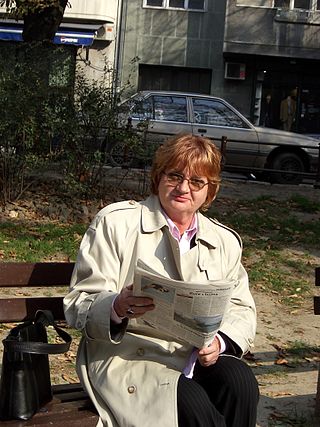
Mirjana Stefanović was a Serbian writer.

Vukov sabor, also known as Vuk's Convocation or Vuk's Fair, is the oldest and most massive cultural event in Serbia. It was named after the reformer of the Serbian language Vuk Karadžić. The central program is traditionally held in September in Vuk's birthplace Tršić, near Loznica. Part of the program is realized in Loznica, Belgrade and the nearby Tronoša Monastery.
Vuk Karadžić Cultural Center is located in Loznica. It was founded on 23 October 1998 by the City of Loznica. The center is responsible for the birth house of Vuk Karadžić in Tršić, Jadar Museum, the gallery of Mića Popović and Vera Božičković Popović, Vuk's House of Culture and other historic and cultural places located on the territory of the City of Loznica. Together with the city of Loznica and Serbian Ministry of Culture and Information, the center is the organizer of Vukov sabor, the oldest cultural event in Serbia.
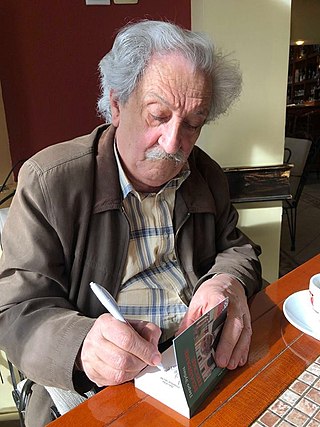
Pero Zubac is a Serbian and former Yugoslav author, poet, screenwriter, academic and journalist. He is a member of the Association of Journalists of Serbia and the Association of Writers of Serbia. In 2021 he was awarded the Order of Karađorđe's Star.

The Monastery of St. Nicholas of Rošci, also known as St. Nicholas Monastery in Kablar, is a Serbian Orthodox monastery located in Rošci, in Moravica district and on the territory of City of Čačak, in the west of Serbia. Dedicated to Saint Nicholas, it is one of the ten monasteries of the Ovčar-Kablar gorge, which for this reason is nicknamed the Serbian Mount Athos, It is home to a community of nuns. It is included in the list of Cultural Monuments of Great Importance of the Republic of Serbia.































